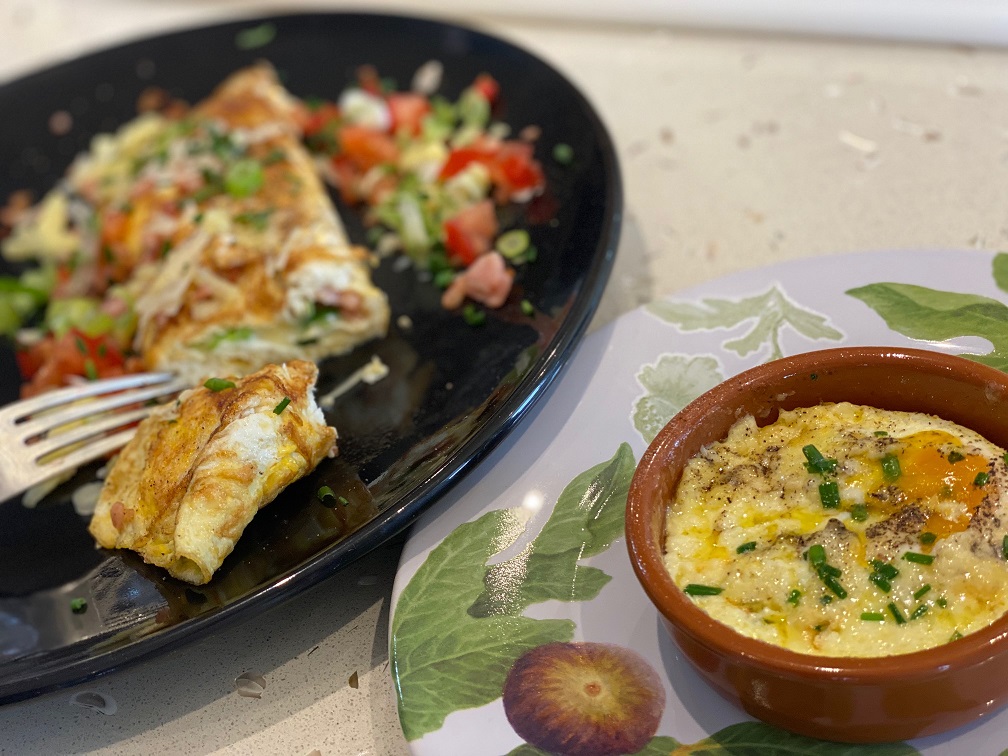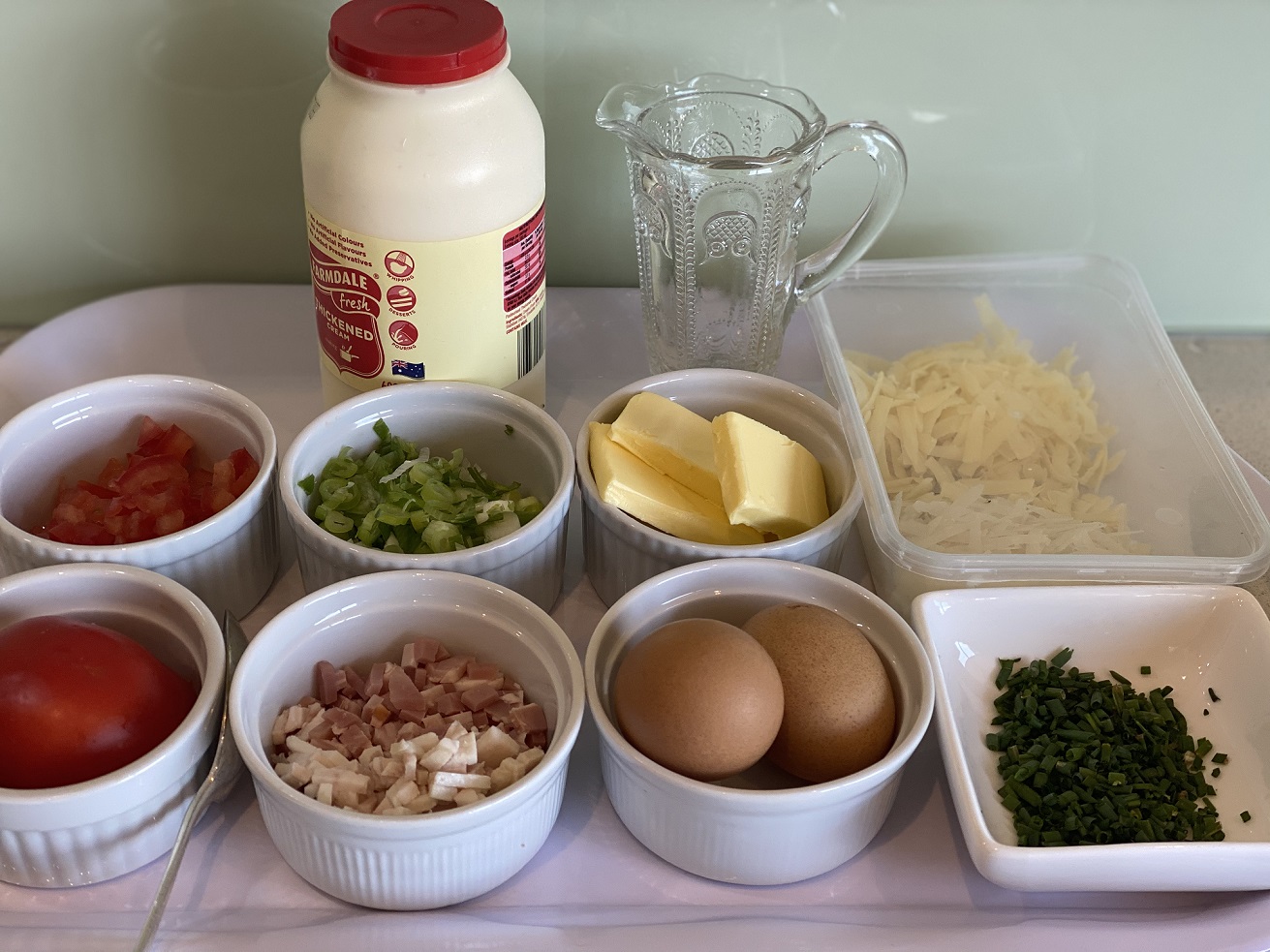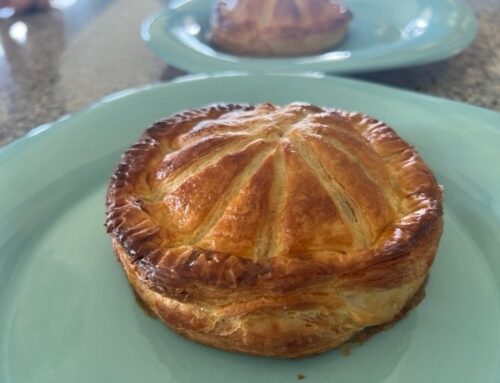The eggs are the essential part of the omelette, the filling is secondary, so do not over-fill them!
The egg is the hero with its buttery taste on the outside of the omelette and the soft runny interior with its simple flavourings inside, it is perfection. Quick, easy and divine! To make a 6 egg omelette for 2 people, use a 30cm pan, or better still make them separately. The fillings are numerous, such as herbs, cheese, ham, bacon, tomato, spring onions, mushrooms, feta, spinach, salmon. The omelette should be light, fluffy and just cooked inside.
Serves 1
| Omelette | Filling |
| 3 x 70g eggs
30 grams butter Sea salt and pepper 25cm pan |
½ tomato concasse
1 – 2 tbsp bacon, finely diced and cooked 1 tsp chives, finely cut 1 tbsp spring onions, finely cut 1 tbsp cheddar cheese, grated |
Equipment: 25cm omelette pan with rounded sides.
Prepare the filling ingredients. For the tomato concasse, slice thinly and remove the seeds and membranes, set aside to use for a Napoli sauce or such. Finely dice the flesh of the tomato. Cut the bacon into small brunoise dice, 3cm x 3 cm and gently cook until the fat is melted and bacon starts to colour nicely. Finely cut the chives and the spring onions, grate the cheese; set aside until time to cook.
Do not pre-beat the eggs, stir them, very lighting with just a fork, immediately before you start to make the omelette. When ready to cook, break the eggs, one at a time into a small jug and add them to the larger bowl. as above, very lightly stir or gently beat them, do not overbeat. Add some sea salt and pepper and 10 grams of the butter.
Heat the pan over medium heat and when warm, add the butter, turn up the heat a little and swirl the butter around the pan to coat the base and sides of the pan. When the butter is frothing, add the eggs and shake the pan to spread the eggs out evenly, then take a fork and draw the edges towards the centre, allowing the pools of liquid egg on the surface to run into the channels you have made. Continue until the omelette is almost set, but the surface is still soft and a little liquid, or as the French say, ‘baveuse’, meaning moist, juicy, runny, a little undercooked.
Remember, the eggs are the essential part of the omelette, the filling is secondary, so do not over-fill them! Using half the quantities above, add the filling, let it settle into the egg and prepare the turn the omelette over. Take the pan handle and tilt the pan, gently with a fork, release the edges of the omelette and turn it over by one third, towards the middle of the pan, take the pan over to the edge of the warmed serving plate, flip the edge of the omelette over and allow it to fold over again as it is turned out of the pan onto the plate.
It is nice to add a teaspoon of butter now, let it melt to make the omelette glisten. Garnish with a light sprinkling of the remaining filling, plus scatter some around the omelette. Enjoy immediately.
Eggs are delicious in every way, whether they are boiled, steamed, poached, scrambled, fried and made into omelettes and eggs en cocotte, or baked eggs.
The eggs are the essential part of the omelette, the filling is secondary, so do not over-fill them!
The egg is the hero with its buttery taste on the outside of the omelette and the soft runny interior with its simple flavourings inside, it is perfection. Quick, easy and divine!
As Elizabeth David so beautifully said about the filling, it is …‘Lying lightly in the centre of the finished omelette, rather than bursting exuberantly out of the seams, it should supply the second of the two different tastes and textures…’ Eggs are the perfect low carbohydrate, healthy fat meal. They provide nutrients, proteins, fats, vitamins and minerals, nearly everything needed for life. Eggs make an easy, quick meal and are something we always have in the larder. And I love them!
- The ingredients ready to cook
- Omelette cooked with bacon, cheese, tomatoes, spring onions and chives








